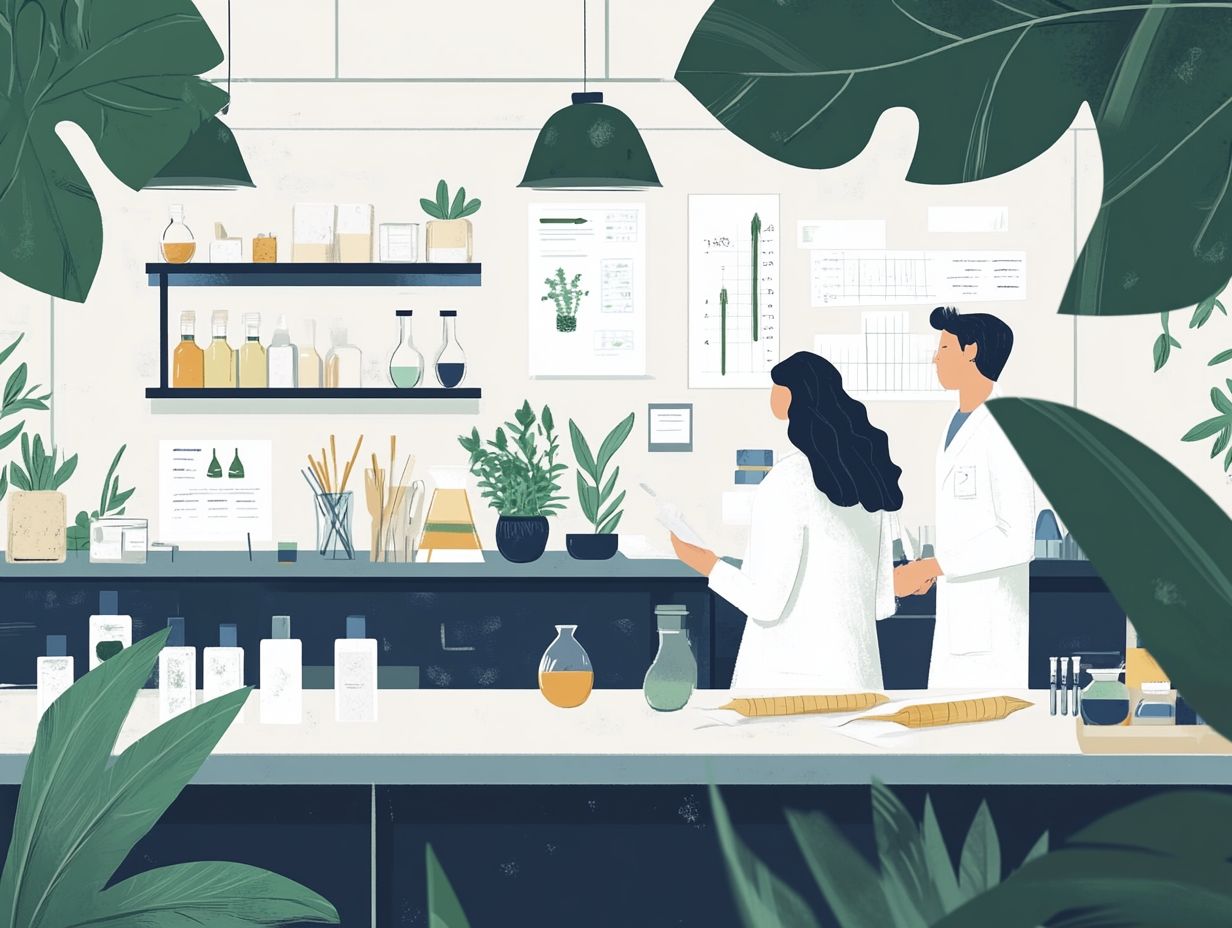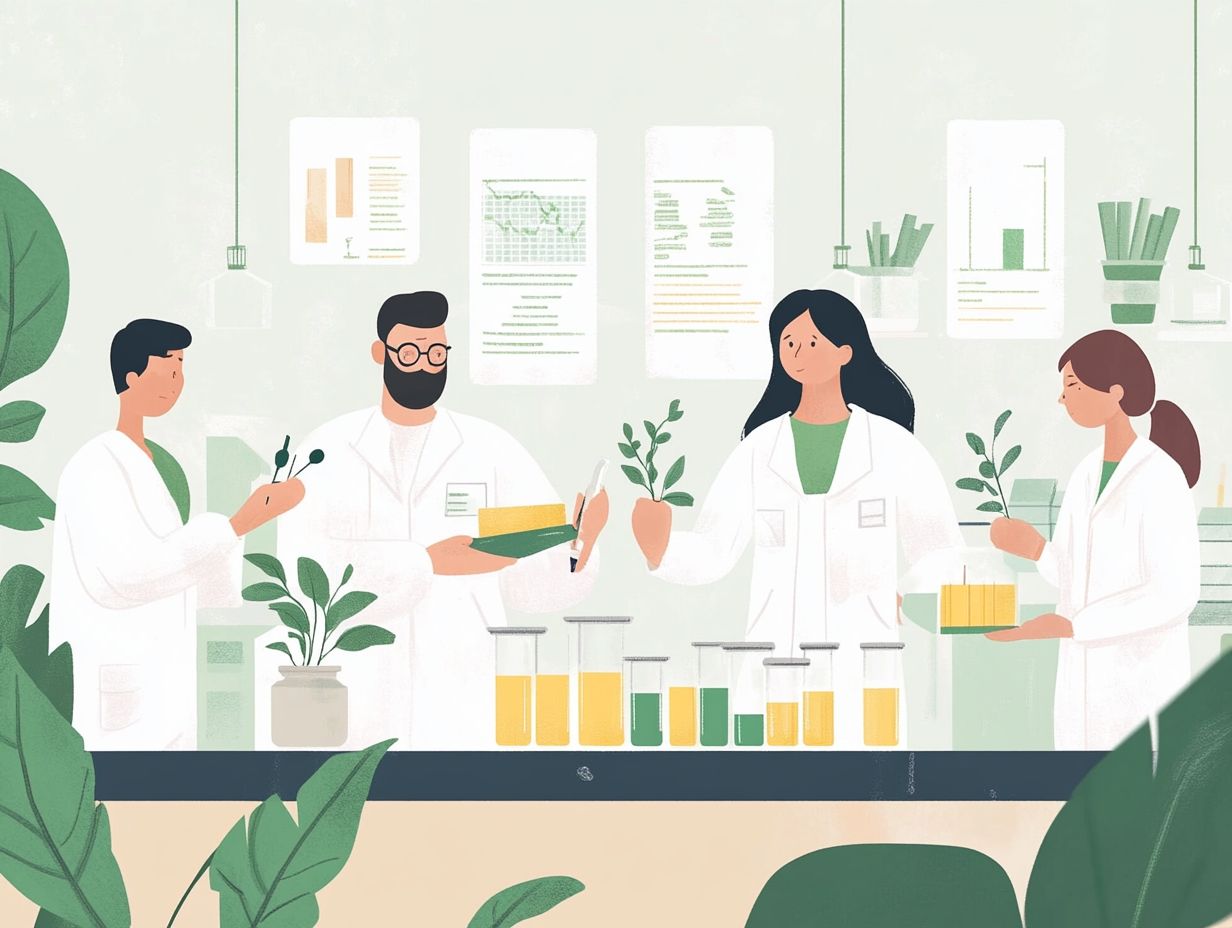The Science Behind Sustainable Material Production
In a time when environmental concerns take center stage, understanding the significance of sustainable material production has never been more crucial for you. This exploration reveals the pressing need to embrace sustainable practices, shedding light on the science that underpins it, such as life cycle assessments and the evaluation of environmental impacts. You’ll discover innovative production techniques that harness renewable energy, along with the vital roles of recycling and upcycling.
The discussion also tackles the challenges that sustainable production faces and highlights the advancements shaping its future. Engage with us as you navigate the path toward a greener, more sustainable world.
Contents
- Key Takeaways:
- The Importance of Sustainable Material Production
- The Science Behind Sustainable Materials
- Sustainable Material Production Techniques
- Challenges and Solutions
- Future of Sustainable Material Production
- Frequently Asked Questions
- What is the definition of sustainable material production?
- Why is sustainable material production important?
- How is science involved in sustainable material production?
- What are some examples of sustainable materials?
- How can sustainable material production benefit businesses?
- What can you do to support sustainable material production?
Key Takeaways:

- Sustainable material production preserves the environment and promotes a healthier future for all living beings.
- Life cycle assessment is a method that looks at the environmental impact of a material from start to finish and is essential for creating sustainable materials.
- Renewable energy sources and recycling/upcycling techniques are key solutions in achieving sustainable material production, but more innovation and advancements are needed for a truly sustainable future.
The Importance of Sustainable Material Production
The significance of sustainable material production cannot be overstated, especially in your quest to balance economic growth with environmental stewardship. As industries increasingly feel the pressure to embrace sustainable practices, you recognize the necessity of minimizing resource consumption and curbing greenhouse gas emissions.
This shift in thinking not only boosts your operational efficiency but also cultivates public trust. Supporting a system that reuses materials helps manage them throughout their life cycle, reducing waste and mitigating harm to the environment.
Why We Need to Shift Towards Sustainability
Shifting towards sustainability is crucial for combating climate change and reducing habitat destruction, toxic chemicals, and biodiversity loss. These elements are imperative for ensuring long-term sustainability and safeguarding the well-being of future generations.
Your current consumption patterns, both in the U.S. and globally, highlight an urgent need to rethink how resources are utilized and how economic strategies are crafted. Unsustainable practices not only lead to environmental degradation but also exacerbate social inequalities, disproportionately impacting vulnerable communities.
Embrace sustainable innovations today to foster economic competitiveness while simultaneously preserving vital ecosystems. This collective responsibility calls for collaborative action from governments, industries, and individuals alike, ensuring proactive measures are taken to tackle these pressing issues.
In doing so, you pave the way for a healthier planet and a more equitable society, benefiting everyone involved.
The Science Behind Sustainable Materials
The essence of sustainable materials lies in comprehending the entire lifecycle of materials from extraction and production to use and disposal. This understanding is crucial for minimizing harm to the environment and optimizing resource-efficient processes within the realm of materials science.
By grasping this cycle, one can make informed decisions that contribute to a more sustainable future.
Understanding Life Cycle Assessment
Life Cycle Assessment (LCA) is a method used to evaluate the environmental impacts at every stage of a product s life. It covers the extraction of raw materials, production, usage, and disposal. LCA is essential for making informed environmental decisions and ensuring regulatory compliance.
By quantifying resource use and emissions in each phase, this methodology provides insights to enhance sustainability in your business. For example, organizations in the building materials sector use LCA to choose eco-friendly options that align with U.S. Environmental Protection Agency (EPA) initiatives to reduce carbon footprints.
These assessments guide industries in creating products that meet regulatory standards. They also highlight programs like the EPA’s WasteWise, which encourages companies to reduce waste and improve efficiency. Real-world applications, such as LCA in the automotive industry, demonstrate its ability to optimize designs for top-notch performance and environmental responsibility.
Evaluating Environmental Impact

Evaluating environmental impacts involves analyzing factors like greenhouse gases, resource management, and pollution mitigation strategies. These elements are crucial for applying effective sustainable practices across various industries.
Accurate assessment methods are vital in this context, including both quantitative measures like carbon emissions calculations and qualitative evaluations, such as stakeholder perceptions. These methodologies are essential for measuring your current environmental footprint and guiding responsible resource management decisions.
By prioritizing sustainability, you can align your operations with broader environmental goals. This ultimately fosters a more harmonious relationship with nature, cuts pollution, and enhances community well-being.
Sustainable Material Production Techniques
Sustainable material production techniques include a range of advanced techniques, such as sustainable manufacturing practices, integrating renewable energy sources, material recycling, and adopting resource-efficient processes.
These approaches aim not just to minimize waste but also to improve operational efficiency, creating a more responsible and environmentally friendly production landscape.
Renewable Energy Sources
Renewable energy sources like solar, wind, and bioenergy are crucial for sustainable manufacturing. They promote energy conservation and significantly support pollution mitigation efforts.
By utilizing these clean power systems, you can cut your carbon footprint and enhance your production processes, leading to significant gains in efficiency and cost-effectiveness.
For instance, integrating solar panels on factory roofs can provide a consistent power supply, reducing your reliance on fossil fuels. You could also harness wind energy for operating machinery, which would lower your operational costs.
Embracing bioenergy not only helps recycle waste materials but also supports local economies. Together, these strategies foster long-term sustainability and enhance your competitiveness in an evolving market. Choosing renewable energy is a smart move that can propel your business forward!
Recycling and Upcycling
Recycling and upcycling are vital sustainable practices that enhance material recycling and resource management. They significantly contribute to waste reduction and foster a circular economy.
Though these concepts are interconnected, they serve distinct purposes and employ different methods in pursuing environmental sustainability. Recycling typically involves processing used materials to create new products. For example, this includes transforming plastic bottles into fibers for clothing or collecting aluminum cans to be remade into fresh containers.
On the other hand, upcycling sparks creativity and innovation by repurposing items into something of greater value. Imagine turning old wooden pallets into stylish furniture or repurposing glass jars as unique light fixtures.
Both approaches play a crucial role in reducing waste, conserving energy, and minimizing the demand for virgin resources. Ultimately, they support a sustainable future.
Challenges and Solutions
The transition to sustainable material production presents a range of challenges, including resource constraints, regulatory hurdles, and technological limitations.
Embracing innovations and developing strategic solutions is vital for navigating these obstacles and successfully reaching your sustainability goals.
Obstacles to Sustainable Production

Obstacles to sustainable production encompass various challenges, including resource constraints, economic competitiveness, and environmental impacts. Maintaining public trust as industries pivot toward more sustainable practices is also critical.
These factors create a complex web that often hinders progress. For instance, when renewable resources are in short supply, industries may be compelled to revert to traditional methods, which can diminish their competitive advantage.
When companies encounter rising costs tied to implementing eco-friendly processes, they may hesitate to fully embrace sustainability. This predicament affects their market standing and shapes public perception. Consumers are becoming increasingly attuned to environmental accountability, and any inconsistency in corporate practices can spark skepticism.
Therefore, navigating these challenges skillfully is essential for businesses looking to enhance both their ecological footprint and financial stability.
Innovations and Solutions
Innovations and sustainable alternatives are essential for tackling the challenges associated with sustainable production. This endeavor demands your collaborative action and research involving different fields to craft solutions that foster long-term sustainability across various sectors.
Recent strides in material science have birthed biodegradable plastics which break down naturally over time and eco-friendly textiles. These advancements not only mitigate environmental impact but also strengthen the circular economy. By weaving together insights from biology, engineering, and design, you can help teams pave the way for more efficient manufacturing practices.
This spirit of collaboration ignites innovation and gives the power to industries to shift toward methods that enhance resource efficiency while minimizing waste.
Such interdisciplinary efforts do more than just stimulate growth; they cultivate sustainable systems that yield benefits for both the planet and society at large.
Future of Sustainable Material Production
The future of sustainable material production presents extraordinary opportunities as technology advances, innovative materials emerge, and sustainable manufacturing practices evolve.
Exciting progress is leading us toward a vibrant, sustainable economy! This offers you the chance to engage with a world that prioritizes environmental responsibility and resource efficiency.
Join the movement for sustainable production today and make a difference!
Advancements and Possibilities
Advancements in sustainable materials and new materials technology create thrilling opportunities for you to engage in climate action and create efficient processes that can transform industries around the globe.
These remarkable innovations include bio-based materials materials made from natural resources that help reduce reliance on fossil fuels, and smart textiles crafted for durability and recyclability. By embracing such sustainable practices, you not only decrease your carbon footprint but also boost your competitiveness in an increasingly eco-conscious market.
The integration of renewable resources and advanced recycling methods ensures that your production methods align harmoniously with ecological considerations. This transition also strengthens resilience against supply chain disruptions while actively promoting a flourishing green economy.
Frequently Asked Questions
What is the definition of sustainable material production?

Sustainable material production refers to the production of materials in a way that minimizes negative environmental impacts and promotes long-term resource sustainability.
Why is sustainable material production important?
Sustainable material production is essential as it helps reduce our overall environmental footprint and promotes understanding the lifecycle of sustainable materials for future generations.
How is science involved in sustainable material production?
Science plays a crucial role by providing research and data on environmental impacts and best practices for producing materials sustainably.
What are some examples of sustainable materials?
Examples of sustainable materials include bamboo, recycled plastic, organic cotton, and biodegradable plastics.
How can sustainable material production benefit businesses?
This practice can benefit businesses by reducing production costs, improving brand image, and attracting environmentally-conscious consumers.
What can you do to support sustainable material production?
You can support sustainable material production by choosing to purchase products made from sustainable materials, properly recycling and disposing of materials, and advocating for sustainable practices in your community.
Join the movement towards sustainability today by making informed choices!






